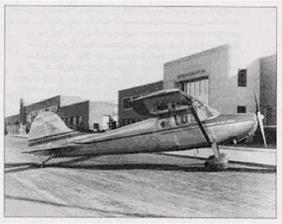The two-seat 120s an
d 140s were great training planes. But a need developed for slightly larger planes with more seating capacity; after learning how to fly, pilots wanted to take the whole family along. The graceful Cessna 170, sort of a flying station wagon, filled that need perfectly when it was introduced in 1947, and as the years passed, the company built models that became larger, faster, and more refined. Perhaps the culmination of these efforts is the high-powered Caravan, a single-engine workhorse that is simultaneously so brawny and graceful that some pilots swear it can carry anything that will fit inside.
|
The Cessna 170 deserves the title of the most graciously designed of all the models to fly out of Clyde Cessna’s Wichita airplane factory. Its elegant lines and attentive interior touches make it a classic that is still popular today. (Photo courtesy of Cessna Aircraft Co.) |
|
By the Book Airplane engines are inherently “dirty" from an aerodynamic point of view, meaning that the air has a lot of nooks and crannies to swirl in, which robs the airplane of speed. Designers shield the engines in cowlings of smooth metal that give airplanes a sleeker look and better performance. |
To say the least, the Cessna company has thrived. Not only is Cessna the unchallenged champion in terms of the number of small, mostly single-engine airplanes that have rolled off its assembly lines—assembly lines that have been owned by Textron since 1992—but the company has also become one of the most prolific producers of small-business jets.













